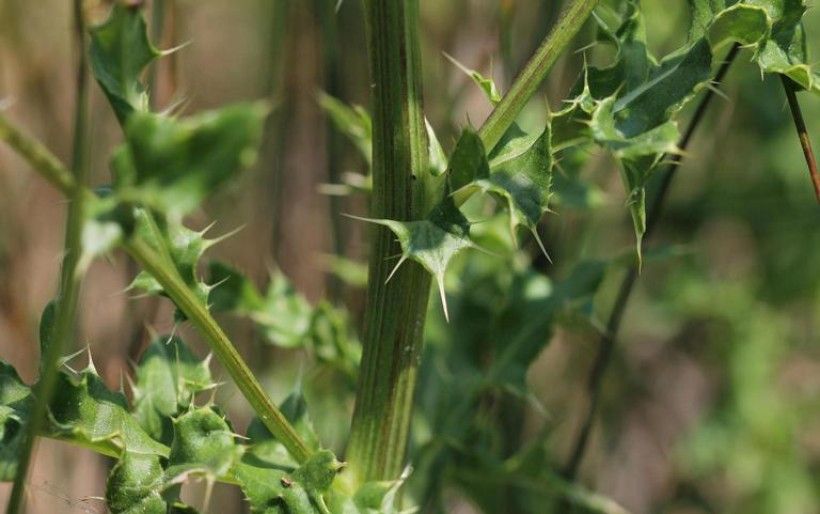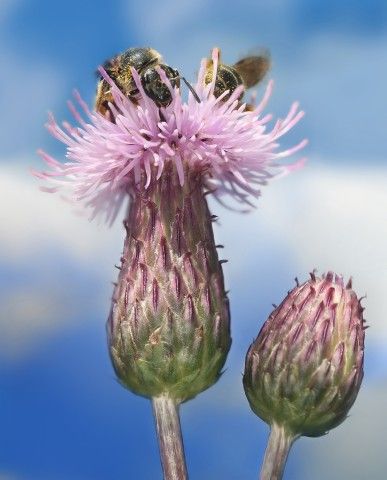Invasive Species Spotlight: Creeping thistle

In Pennsylvania, Creeping thistle (Cirsium arvense) has a recorded presence approaching 200 years, with the first recorded observation of the species in the Commonwealth happening in the Great Valley near Malvern in 1828. Even then, farmers, botanists, and legislators recognized the threat posed by an established population, and legislation for its control was enacted in 1862. Despite this early awareness, the species established populations throughout the country. Today, it is considered a noxious weed in 43 states.

Description
Creeping thistle (Cirsium arvense), also called Canada thistle, field thistle, swamp thistle, and thistle, is an herbaceous, rhizomatous perennial weed that prefers moist soils with full sun but also colonizes disturbed sites. Its root system, which can reach depths of 6 feet below soil surface, allows it to aggressively sprout and makes it difficult to suppress. Plant physiology varies between populations but, generally, the plant grows to be 1-5 feet tall with lanceolate, sessile leaves that have hairs on their undersides and prickly margins. This invasive begins flowering in June and continues through September. Its female flowers are roughly 0.5 inches in diameter and can be purple, pink, or white. Once the flowerhead matures, it produces seeds similar to milkweed seeds that have a feathery plume that catches the wind and carries them up to 0.6 miles from their origin.
Origin
Native to southeastern Europe and the Mediterranean basin, Cirsium arvense was first introduced to North America in the 17th century. It was initially believed to have been introduced to the American colonies by French soldiers coming from New France, which is likely the origin of the common name “Canada thistle,” though later research supports the theory that it was independently introduced in New England via seed contamination.

Lookalikes
There are several other members of the Cirsium genus, including native species, that look similar to Cirsium arvense. Cirsium discolor (“field thistle”), Cirsium horridulum (“bull thistle”), and Cirsium muticum (“swamp thistle”) are all examples of such species. That the common names of many native thistles are also common names for Cirsium arvense should indicate the problems that can arise from relying solely on common names for identification. Cirsium discolor can be distinguished from Cirsium arvense by its leaves, which have narrower lobes and deeper divides than those of Cirsium arvense. Cirsium horridulum can be distinguished by the woolly undersides of its leaves, and it is larger than Cirsium arvense. Cirsium muticum also has leaves with woolly undersides but grows on wet sites. Most native thistles are biennials and have a taproot, while Cirsium arvense is a perennical that produces rhizomes.



Control
On sites where Cirsium arvense is not yet established, colonization can be prevented by maintaining inhospitable site conditions for the species. Cirsium arvense colonizes sites with ample sunlight, such as those recently disturbed or areas with established but sparse turf cover. Open sites with turf cover should be managed to maintain a continuous, dense cover, and, if Cirsium arvense does appear, the site should be mowed regularly. Broadleaf, post-emergent herbicide application can also help control the species, though it should be integrated with other control methods like repeated cutting. Herbicide application alone is often insufficient for killing the pant down to the roots. When selecting herbicides, look for products containing aminopyralid and 2,4-D (such as NativeKlean) or products containing clopyralid (such as Lontrel). Time application after the rosettes have formed but before the plant has developed seedheads.
References:
- Invasive.org Canada Thistle Cirsium arvense
- NC State Extension Cirsium arvense
- PA Dept of Agriculture Canada Thistle, Cirsium arvense
- PSU Extension Canada Thistle [Cirsium arvense]
- USFS FEIS Species: Cirsium arvense
- Friends of the Wildflower Garden: Thistles Comparison
Header image: Cirsium arvense (Creeping thistle), Ivar Leidus via Wikimedia Commons